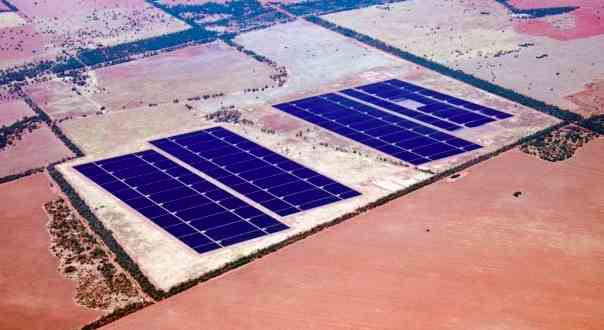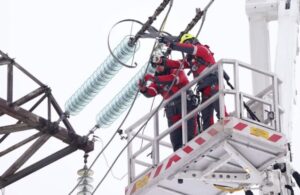In a ceremony attended by the heads of AGL Energy and First Solar, and ministers from the NSW government – but not the federal government – the last and 1,366,380th solar panel was installed on the 102MW Nyngan solar farm in western NSW on Friday.
And while it is a welcome thought that Australia has finally made it onto the big solar map, it also highlights just what could have been for big solar in Australia.
The Nyngan solar farm will, for a short time, be the biggest solar farm in the southern hemisphere, and will be quickly followed by its sister project, the 53MW solar farm in Broken Hill. But beyond that, and the equally heavily subsidised 56MW solar farm in Moree, the outlook for big solar in Australia is bleak.
That’s a shame, and a story of missed opportunity. Australia has some of the best resources for solar in the world, and wide open spaces. But it currently ranks no 31 in terms of big solar in the world, and even these projects won’t get it into the top 20.
The chance of Australia breaking through that barrier any time soon seems remote. The uncertainty around the renewable energy target means all investment in large-scale solar projects has ground to a halt – bar an innovative floating solar plant in South Australia. The prospect of an agreed cut in the RET from 41,000GWh to 33,500GWh or 32,000GWh mean that wind energy will fill most of the reduced target.
The contrast with South Africa, another coal dependent country, could not be greater. It has so far contracted for more than 5,000MW of large scale wind and solar and announced overnight it would look to install another 6,300MW – much of this solar PV and solar thermal, where it has become a leader in the global market.
In Australia, the completion of the Nyngan installation was accompanied by the connection to the grid of another 25MW block. The rest will be connected in June or July. This graph shows the contribution of the 50MW now connected to the grid. You can see more information in RenewEconomy’s live generation data here.
Andrew Vesey, the new CEO of AGL Energy, which financed the plant with the help of a $231 million grant from the Australian Renewable Energy Agency ($166 million) and the NSW government ($64 million), described the plant as an “important part of AGL’s journey towards a decarbonised electricity generation portfolio”.
“We are pleased to be adding to AGL’s and Australia’s portfolio of renewable energy generation and assets,” Vesey said on Friday. However, AGL has been a vocal advocate to cut the RET, or to drop the scheme altogether. It has invested billions in coal-fired generation in recent years, although it now recognises the potential impact of new technologies such as rooftop solar, and storage, on its centralised business model.
Ivor Frischknecht, the head of the Australian Renewable Energy Agency, justified the funding for the two projects, saying the knowledge gained would make it “easier and cheaper to develop large-scale solar plants in Australia by helping reduce financial, regulatory and technical barriers.”
First Solar’s head of operations in Australia, Jack Curtis, agrees.
Curtis says the Nyngan and Broken Hill projects have been critical in showing that solar PV is a mainstream energy source, and that costs can be brought down quickly.
For instance, the mounting structures provided by Australian firm IXL were cheaper than those that could be supplied by Chinese rivals. Local contractors have also found they can install poles and panels at much greater speed – and therefore lower cost – than they thought.
But apart from this “suprising evolution” in the supply chain, the big ticket item for costs is finance.
Curtis says the US is the key barometer for prices for large-scale solar farms. After backing out of subsidies, the US market is seeing prices in the $90-100/MWh mark.
“If we can do that here, large-scale solar will be competing against wind,” Curtis said. “But in Australia, the cost is probably around $140/MWh, and it could be another 3-4 years until the solar can hit the same numbers as the US.”
“Finance will be a big key to that,” he added. But finance costs in Australia will likely come down slowly because the deployment rate will be vastly inferior to that in the US, where innovative financing structures and corporate interest have brought down the costs.
“If we had a clear policy backdrop that would create big solar development in Australia, costs would come down a lot quicker,” Curtis told RenewEconomy in an interview.
Curtis says he is concerned that a reduced RET would allow “a big bunch of wind” to be deployed before solar can compete. “That is a concern of ours, but having a resolution in some form is more appealing than having something that may not realised.”
Some resolution on the RET would unlock a few solar projects, but these were likely to be at the smaller end of the market – in off-grid and remote locations, and “behind the meter” – and projects sponsored by corporate interest.
As RenewEconomy has reported, there are several “mega-scale” solar projects in the pipeline, and other large-scale projects, but many of these would not get the go ahead under a reduced RET. At 41,000GWh, Bloomberg New Energy Finance suggested half the around 8,000MW needed to meet the target could be from big solar.
Still, developers in WA are confident their projects can go ahead, because of the unique nature of that market, and there are numerous smaller projects that could also get the tick of approval, and finance, if a resolution is found.












